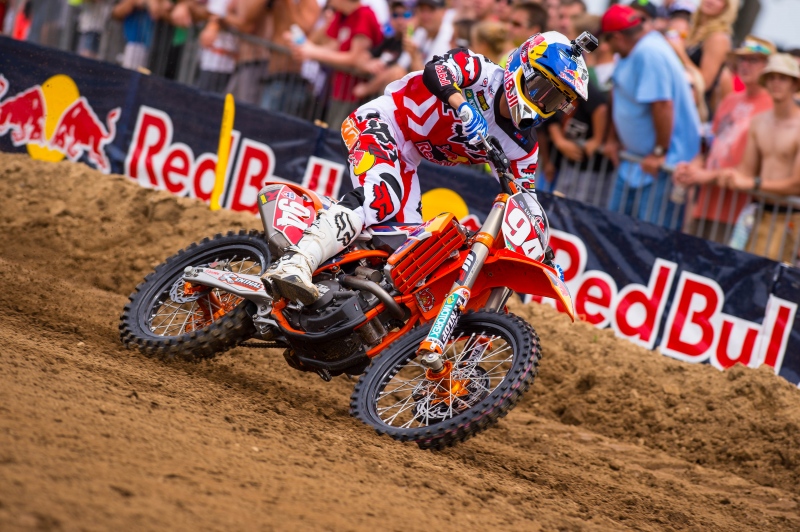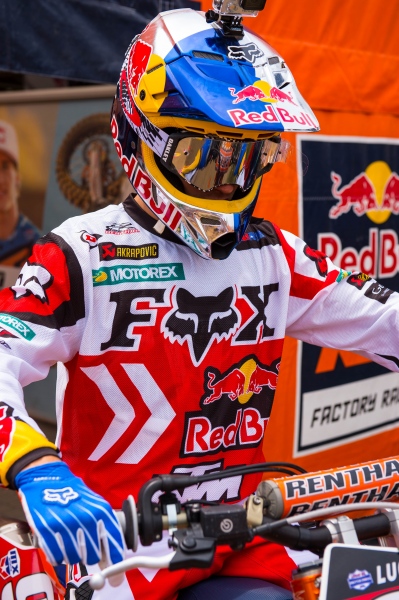Jason Thomas’s weekly column on the industry
Jason Thomas’s weekly column on the industry
Hammerhead Designs was launched with the intent to provide new and better parts and innovative accessories for motocross bikes. One of our goals has been to design entirely new and unique products with improved ergonomics and the shift lever was the first part that we felt could be dramatically improved by providing a feature that would allow for the shifter to be repositioned to perfectly suit the riders size, shape, and preference.
Photos by Simon Cudby
There was a pretty interesting bidding process that went on a couple of months ago involving the rider that I consider to be the most marketable rider on the planet, Ken Roczen. His apparel contract was expiring at the end of 2014 and for interested parties, it was go time. This dealing went on for quite a while and to be honest, I was very unsure of where he would end up. Two of the players were both very serious and each had their benefits and persuasive tactics. Let’s take a look at what makes Roczen so coveted and how a situation like this plays out.
 |
|
“Roczen embodies so many of the crucial characteristics that companies are seeking. Coming from Germany and being a former MX2 World Champion, he is much more of a global icon than a rider who has only succeeded on one continent. He knows the Euro lingo but his accent is hardly noticeable when speaking English. He is a winner and has been since he was a kid.” |
Riders all have their own unique personalities and fan bases accordingly. Some are straight laced and predictable, some are very edgy and some are a downright gamble as to what they will do or say next. The ideal marketing plan would be to have a mix of these guys in order to appeal to every layer of the customer base. A company doesn’t want to pigeon hole themselves as that excludes other portions of the market. Having a rider for the “family” market is a huge draw as this is, after all, a family sport. Having said that, not marketing a rider for not only the “Generation X” market but also the maturing “Generation Y” market is a huge mistake. They represent a huge part of the 18-35 year old demographic that seems to be crucial for the motocross/supercross world. Brands like Red Bull, Monster and Rockstar are spending tens of millions of dollars in this sport, actively pursuing this exact customer. Not only acquiring that particular sale but hopes of earning a customer for life is the big picture goal. Loyal customers are the life blood of a company and all of the branding efforts that go into a company’s marketing scheme are aimed at just that.
A company like Red Bull sees great value in Ken Roczen as he becomes synonymous with their product and overall perception. Every time he does a big turn down and wows the crowd, there is a small bit of subconscious remembrance that he is a Red Bull athlete. Or at least that’s the hope of every marketing manager alive. What’s relevant here, though, is that Roczen is the perfect storm for these companies.
Roczen embodies so many of the crucial characteristics that companies are seeking. Coming from Germany and being a former MX2 World Champion, he is much more of a global icon than a rider who has only succeeded on one continent. He knows the Euro lingo but his accent is hardly noticeable when speaking English. He is a winner and has been since he was a kid. Every class, every series, every size bike, he has won races and been on an elite level. His style on the bike is off the charts and fans everywhere mimic, or at least try to mimic, his flashy technique. He is incredibly popular on social media and for this generation and the next, social media’s importance can’t be overemphasized. He is the perfect embodiment of the phrase “guys want to be him and girls want to be with him”. That is it in a nutshell. The casual fan is heavily influenced by what he chooses to wear and ride and companies know it. There are very few riders in this sport than can directly influence sales and the young German is one of them.
 |
|
“The battle for Roczen’s services was interesting for me to witness as an outsider. I work in this same gear industry and although I wasn’t involved, I certainly heard plenty of updates and followed the twists and turns as it unfolded. For a rider like Roczen, the financial payment is considerable. The upper echelon for these guys is right at or just above 7 figures.” |
The battle for Roczen’s services was interesting for me to witness as an outsider. I work in this same gear industry and although I wasn’t involved, I certainly heard plenty of updates and followed the twists and turns as it unfolded. For a rider like Roczen, the financial payment is considerable. The upper echelon for these guys is right at or just above 7 figures. This is a very rare air and I only know of one rider solidly in the 7 figure range. Roczen’s offers had a few different angles, one was more money but shorter term and the other was less money but a longer commitment. Another aspect was how the goggle agreement would shake out and how each company could use their distribution influences. The goggles couldn’t make or break the deal but it certainly brought interesting possibilities to the table. Boots were also in consideration as most companies are aiming at a “head to toe” contract in order to market all array of products in their catalog. It gets complicated when you start trying to piece together all of the individual details of a gear deal. Not only the gear but what boot companies comply to what gear and which goggle companies do business with the associated helmet. This can drag on for some time and makes the head-to-toe deal more attractive due to simplicity.
For the payment terms, it gets tricky as to which deal would be more attractive and comes down to a few factors. A) do you value stability and long term assurance or B) a higher payment now but be re-evaluated in 2 years. For instance, if Deal A was for 5 years at $800,000 per year, that would be a 4 million dollar deal before any bonuses. Deal B could be a 2 year deal at $1,000,000 per year for a total of 2 million dollars. The rider and agent have to consider where the market will be in 2 years and also what will said rider’s value be in 2 years. It’s a risk versus reward play. If Kenny goes on to win titles over the next 2 years then obviously he will be able to write his own check when it’s time to re-sign. However, if he had some unfortunate mishap and his results suffered due to any number of reasons, his value may be significantly less than the $800,000 he was guaranteed with the 5 year deal. Another question, what is the ceiling for a contract? In other words, if he does win and is at maximum value in 2016, how much potential is there for a bigger deal? My best guess is that his ceiling would be $1.3 million-$1.4 million dollars at the end of a 2 year deal in which he won championships. That’s in an absolute best case scenario.
On the other hand, if his value dropped due to injury or poor performance, his value could easily drop to the $400,000 range in an instant. Taking those numbers as an example, we can estimate his risk. With Deal A, he is guaranteed his $4 million, as we said earlier. With Deal B, he will re-negotiate at his then market value. His best case scenario would be 2 million for the first 2 years then another 3.9 million or so for the other 3 years. That would bring his grand total to 5.9 million over 5 years. Not too shabby. Of course, we have to also figure the potential loss as well. Take his guaranteed 2 million and then let’s say he struggled and his value dropped to the 400,000 mark we used earlier. That would bring him down to 3.2 million over the same 5 year span. So, as you can see, that would leave $800,000 of guaranteed money on the table if things didn’t go well. All of this brings up the timeless question of “are you willing to bet on yourself?”. There is a lot of money to be made if that bet pays off.
The final aspect in this scenario is brand loyalty from the rider. I think this was the deciding factor above all else as Roczen just didn’t want to leave the company he had been with for a decade. Negotiations can weave all over the map but if both sides end up being relatively close, it often comes down to where the rider wants to be and what feels the most comfortable. I think this was the case here.
Many riders will have very easy contract negotiations and it can be finalized in days. Other times, such as Eli Tomac’s choice between Geico Honda, RCH Suzuki and others last year, was very complicated and dragged on for months. The usual reason is simply demand. The more desirable the rider, the more offers he will entertain and back and forth we go. It is a fun situation to watch unfold and hopefully this sheds a little bit of light into what it all entails… If not, go watch Jerry Maguire again and get back to me.





